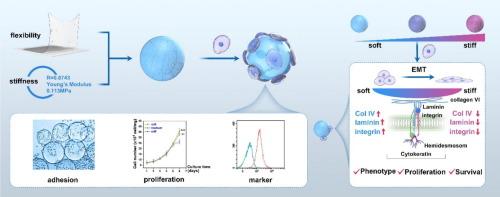微载体刚度通过重塑ECM和Wnt/β-catenin通路控制人羊膜上皮细胞(hAECs)增殖和上皮-间质转化(EMT)
IF 13.2
1区 工程技术
Q1 ENGINEERING, CHEMICAL
引用次数: 0
摘要
人羊膜上皮细胞(hAECs)由于其低免疫原性和致瘤潜能水平而成为再生医学应用的理想候选者。然而,体外培养hAECs受到其有限的增殖能力和不明确的细胞特性的挑战。微载体硬度是体外培养hAECs上皮间质转化(EMT)的关键。本研究通过转录组学分析监测微载体刚度下细胞增殖、表型和代谢活性的变化,揭示了微载体刚度在haec增殖和EMT进展中的调节作用。微载体硬度的增加抑制了hAECs的增殖和上皮表型维持,这与细胞外基质(ECM)的重塑和ECM-整合素的相互作用有关,此外还激活了Wnt/β-catenin信号通路。这些发现为hAECs增殖的机械调控和hAECs表型提供了新的见解,为其规模化发展铺平了道路。本文章由计算机程序翻译,如有差异,请以英文原文为准。

Microcarrier stiffness controls human amniotic epithelial cells (hAECs) proliferation and epithelial-mesenchymal transition (EMT) via remodeling ECM and Wnt/β-catenin pathway
Human amniotic epithelial cells (hAECs) are ideal candidates for use in regenerative medicine because of their low immunogenicities and levels of tumorigenic potential. However, the in vitro cultivation of hAECs is challenged by their limited proliferative capacities and ambiguous cellular characteristics. Microcarrier stiffness is crucial in the immediate epithelial-mesenchymal transition (EMT) of hAECs upon in vitro cultivation. By monitoring changes in cellular proliferation, phenotypic, and metabolic activity under microcarrier stiffnesses via transcriptomic analysis, this study revealed the regulatory roles of microcarrier stiffness in the proliferation and EMT progression of hAECs. An increased microcarrier stiffness inhibits the proliferation and epithelial phenotype maintenance of hAECs, which is linked to the remodeling of the extracellular matrix (ECM) and ECM-integrin interactions, in addition to the activation of the Wnt/β-catenin signaling pathway. These findings provide novel insights into the mechanical regulation of hAECs proliferation and phenotypes of hAECs, paving the way for their scale-up.
求助全文
通过发布文献求助,成功后即可免费获取论文全文。
去求助
来源期刊

Chemical Engineering Journal
工程技术-工程:化工
CiteScore
21.70
自引率
9.30%
发文量
6781
审稿时长
2.4 months
期刊介绍:
The Chemical Engineering Journal is an international research journal that invites contributions of original and novel fundamental research. It aims to provide an international platform for presenting original fundamental research, interpretative reviews, and discussions on new developments in chemical engineering. The journal welcomes papers that describe novel theory and its practical application, as well as those that demonstrate the transfer of techniques from other disciplines. It also welcomes reports on carefully conducted experimental work that is soundly interpreted. The main focus of the journal is on original and rigorous research results that have broad significance. The Catalysis section within the Chemical Engineering Journal focuses specifically on Experimental and Theoretical studies in the fields of heterogeneous catalysis, molecular catalysis, and biocatalysis. These studies have industrial impact on various sectors such as chemicals, energy, materials, foods, healthcare, and environmental protection.
 求助内容:
求助内容: 应助结果提醒方式:
应助结果提醒方式:


